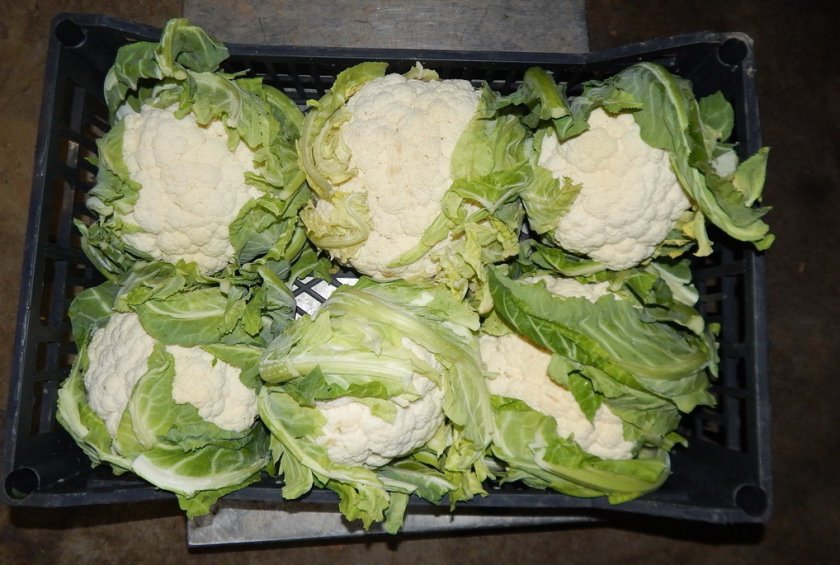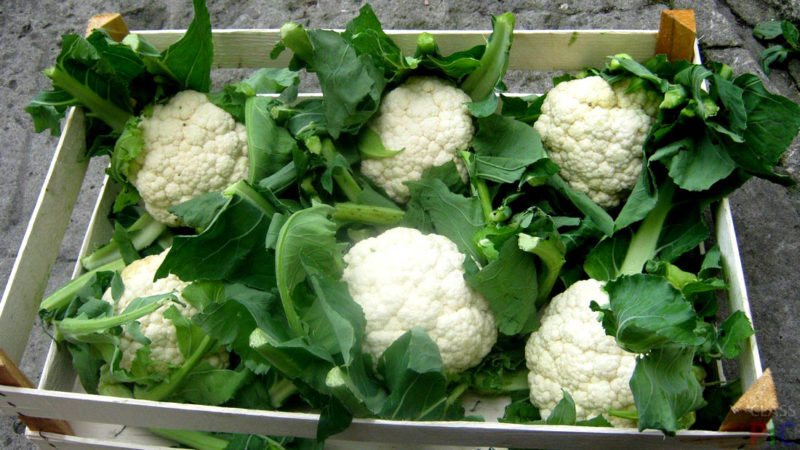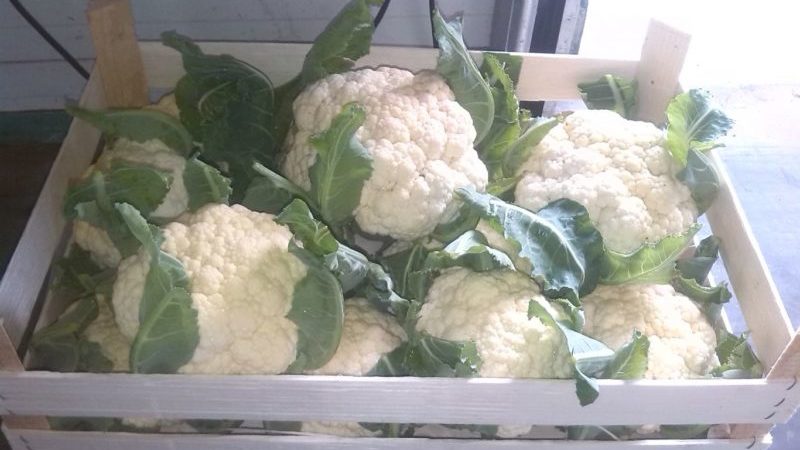The best ways to keep cauliflower for the winter at home
Cauliflower is considered finicky not only in cultivation but also in storage. To keep a vegetable fit for food during the winter, you need to provide both proper care during the growing season and suitable conditions during storage. It is important to choose a suitable place, storage method, to decide on a variety that has a long shelf life.
The content of the article
Is it possible to keep self-grown cauliflower fresh for the winter?
Any gardener dreams of preserving his harvest in the winter. For long-term storage, a suitable variety is grown; excessive nitrogen dressings are not used, leading to rapid spoilage of products. When grown on its own, it is easier to control the ripening of the forks. The crop is placed in the necessary conditions using various methods: freezing, drying, canning, and others.
Selecting and preparing cabbage for storage
For preservation for a long time, choose not overripe, healthy, evenly colored inflorescences. Vegetables are harvested as they ripen. Overripe cabbage loses its taste and keeping quality. The most suitable forks are considered to be 10-13 cm in size, weighing 0.5-1 kg.
The harvested crop cannot be kept in the sun - under its influence, the inflorescences wither. After harvesting, the forks are transferred to a cold, dark room. Before laying, stubs and integumentary leaves are cut for a long time, leaving 3-4 leaves. They will protect the forks from damage and deterioration. The cabbage is dried and placed in storage.

Depending on the variety
Early varieties have poor keeping quality; only late-ripening ones are suitable for long-term placement. They ripen within 140-150 days from the moment of germination. Late varieties have dense, large heads, characterized by long keeping quality. These varieties include Agnia, Amerigo, Green Snowdrift, Cortes, Regent.
Storage space
Cauliflower is stored in a variety of ways. Optimal conditions: temperature - 0 ... + 5 ° C, humidity - 90-95%. When the recommended temperature drops, the vegetable will freeze, and when the temperature rises, it will begin to sprout. The best storage places are cellar, refrigerator, balcony.
In a refrigerator
For placement in the refrigerator, forks are prepared as follows:
- Wash thoroughly and remove leaves. Divided into inflorescences, laid out on a clean towel to dry.
- The dried inflorescences are wrapped in two layers of cling film, thus limiting the access of air.
- Placed in the vegetable compartment.
In this form, the vegetable is stored for up to 16-18 days. The cling film is periodically changed, as condensation forms on it inside. This leads to product decay.
On the balcony
In the absence of a cellar, the harvest is saved on the balcony. The heads are placed in wooden or plastic boxes filled with sand and tightly covered with an opaque film. This is necessary to maintain moisture inside the container.
Also, forks are placed on the shelves of the closed balcony cabinets. The inflorescences are pre-wrapped with cling film. Every 5-6 days the vegetables are inspected, the film with condensation is changed.
Attention! When the air temperature drops below 0 ° C, drawers and shelves should be covered with old blankets.
The best conditions are created on a glazed loggia, where the temperature does not drop to minus marks.
In the basement or cellar
In the conditions of the cellar and basement, cabbage does not lose its beneficial properties for 3-4 months. Before laying the crop, the walls, ceiling and floor are carefully treated with antiseptic agents. In the room, air is circulated through two ventilation holes: fresh air enters the first, and the vapors of stored vegetables are removed through the other. They create the necessary microclimate with an air temperature of 0 ... + 5 ° C and a humidity of 90-95%.
Pre-washed and dried heads without stubs and with 3-4 integumentary leaves are placed in a wooden or plastic container, laid out on the floor, shelves, and suspended from the ceiling. Periodically, vegetables are examined, monitoring the onset of the process of decay and disease. The spoiled forks are removed so that putrefactive processes do not spread to neighboring vegetables.
Storage methods
Experienced gardeners recommend different ways of storing cauliflower during the cold season. Before using each method, you should study the rules for processing vegetables.
In paper
In a paper wrapper, cauliflower stays for 2-3 months. Before laying, the heads are washed with running water and dried. Then the heads of cabbage are individually wrapped in 3-4 layers of clean paper and placed in boxes or laid out on the shelves of the cellar.
Important! Newspapers and magazines are not allowed as a paper layer. Printing ink contains lead and benzene that are harmful to health.
Vegetables wrapped in paper are checked periodically. If there are wet spots on the paper, the products are unrolled, inspected, the paper is replaced with dry paper.
In clay
The vegetable is well preserved in a layer of clay. This method is suitable for those who do not have a very large harvest. Each head of cabbage is coated with a solution of sour cream consistency. Do the following:
- Clay is diluted with water in a 1: 2 ratio.
- Stir until smooth.
- The heads are dipped in the solution and hung in the open air to dry.
- After the clay layer has hardened, the forks are placed in boxes, on shelves, and suspended from the ceiling of the cellar.
To release the dry clay shell, hit it with a hard object. The broken-off clay does not leave marks on the inflorescences.
Thanks to this method, cabbage does not rot, does not dry, and retains freshness for 5-6 months.
In boxes

For storage in the basement, wooden boxes are used. Before placing in containers:
- The stump is removed along with the green mass, leaving 2-3 leaves.
- The heads are placed in clean boxes lined with dry paper.
- Partitions are made of cardboard between the vegetables so that the heads do not touch.
- You can wrap the cabbage with cling film.
- Cover the boxes with an opaque film to maintain moisture.
Some growers put cabbage dug up by the roots in boxes of sand. The stump and leaves are not removed. A small hole is made in a slightly moistened (not wet) sand, in which the lower part of the head is placed - a stump with roots, as if planting the plant in the sand. In this state, the vegetable does not deteriorate for up to two months.
In limbo
A well-proven method of storing heads by hanging them by stumps. It is not recommended to remove the leaves, they serve as a protective shell from drying out. The cabbage is hung so that the heads of cabbage do not touch themselves for better air access. In this state, vegetables retain their quality for about 6 months.
Storing cauliflower with growing
Growing cabbage is the best option if the heads have not matured before the start of harvesting. 3-5 days before harvesting, unripe, but healthy vegetables are watered, then dug up with roots and a large clod of earth. Boxes filled with earth are prepared in advance.
The heads of cabbage are planted tightly to each other and sprinkled with soil until the integumentary leaves. Moisten as the soil dries. To ensure air circulation, the room must be ventilated.Growing lasts 3-4 months, depending on the selected variety, during which the heads gain the required weight.
other methods
The keeping quality of a vegetable depends not only on the variety, but also on how it is stored: frozen, dried or canned.

Freezing
The longest shelf life of heads is achieved in the freezer - about a year... The frozen vegetable is used for cooking soups, stewing vegetable stews. Before freezing, the heads are thoroughly washed with running water, dark inflorescences, leaves and stump are removed, divided into inflorescences. They are blanched in boiling water for 3-4 minutes, after which they are immediately immersed in cold water. After defrosting, blanched cabbage will not become lethargic, soft, retain its elasticity. Prepared inflorescences are laid out in food containers or packed in plastic wrap and placed in a freezer.
Drying
Dry, the vegetable retains its beneficial properties for about a year. It is used in vegetable soups. An oven or dehydrator is used to dry the vegetable. First, the heads of cabbage are washed and cut into small inflorescences. When using the oven, cover the baking sheet with clean paper, lay the chopped vegetable on it in one layer. Cauliflower is dried at 55-60 ° C. Since it contains a lot of moisture, the drying process takes 5-6 hours. The oven door is not closed tightly, leaving a small gap, substituting some metal object 0.5-0.7 mm thick. This is to evaporate moisture from the oven. Otherwise, the vegetable will start stewing in its own juice.
For drying in a dehydrator, vegetables are placed in special trays and the machine is turned on. This method allows you to get a better quality product while maintaining useful properties. In conventional dryers for vegetables, only the outer parts dry out, a small percentage of moisture remains in the pulp. This leads to deterioration of vegetables during storage.
Canning
Canned cauliflower stored for a long time. It is rolled up along with other vegetables. For preservation use, for example, the following recipe:
- Prepare a brine: dissolve 50 g of salt, 50 g of sugar, 1 tbsp in 1 liter of water. l. vinegar and bring to a boil.
- Spices are laid out at the bottom of sterile jars: 5-6 pieces of black and allspice, 2 bay leaves, bell pepper cut into slices, garlic.
- Pre-divided into inflorescences and blanched cabbage is placed in jars and poured with brine. Banks are placed in wide pots of water, brought to a boil and boiled for 7-8 minutes.
- After that, the cans are rolled up with lids.
Storage periods

Cauliflower retains its beneficial properties for up to 12 months, depending on conditions. You just need to follow the recommended rules when preparing vegetables and choose a suitable storage method.
Healthy, intact cauliflower heads can sit at room temperature for 12-20 days. Long shelf life is reached:
- in the refrigerator under the freezer at a temperature of 0 ... + 3 ° C - up to 2.5-3 months;
- in the vegetable compartment at + 2 ... + 4 ° C - 50-60 days;
- in the freezer - 12 months;
- in the cellar (basement) at a temperature of 0 ... + 5 ° C - 2-2.5 months;
- on the balcony at a temperature of 0 ... + 6 ° C - 1.5-2 months.
Read also:
How to prepare Korean cauliflower for the winter.
Conclusion
How to keep cauliflower for the winter at home? For this use freeze, drying, canning, as well as various methods of fresh storage. Cauliflower can be stored for 20 days to 12 months, depending on conditions. To extend this period, it is necessary to choose a mature variety and observe the correct agricultural techniques when growing. During the entire storage period, it is important to regularly check the condition of the vegetables.